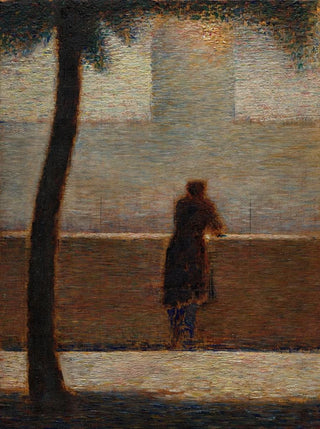Art print | A man leaning on a parapet - Georges Seurat


View from behind

Frame (optional)
The artwork "A man leaning on a parapet" by Georges Seurat is an iconic piece that embodies the essence of pointillism, a revolutionary artistic movement of the 19th century. Gazing at this piece, the viewer is immediately transported into the tranquil world of a riverside walk, where light plays with shapes and colors. Seurat, with his meticulous approach and keen sense of composition, manages to capture an atmosphere that is both peaceful and contemplative. This painting, both simple and complex, invites a deep exploration of human emotions and sensations. The depiction of a thoughtful man leaning on a parapet evokes reflections on solitude, contemplation, and the passage of time, making this work a true mirror of the soul.
Style and uniqueness of the work
Seurat's style is distinguished by his innovative use of color and light. In "A man leaning on a parapet," each dot of color, carefully applied, contributes to creating a visual harmony that transcends mere representation. The pointillism technique not only brings landscapes to life but also enriches the emotions of the characters. Delicate shades of blue and green evoke serenity and depth of the scene, while the man's posture, both relaxed and thoughtful, suggests introspection that resonates with the viewer. This painting is an invitation to contemplation, a work that, through its apparent simplicity, reveals layers of complexity and emotion, typical of Seurat's genius.
The artist and his influence
Georges Seurat, a central figure of the Impressionist movement, redefined the standards of painting in his time. Born in 1859, he quickly developed a unique technique that influenced many contemporary and future artists. His scientific approach to color, inspired by theories of visual perception, paved the way for new artistic explorations. Seurat mastered the marriage of art and science, creating an aesthetic that continues to inspire generations. His work "A man leaning on a parapet" bears witness to this constant pursuit of harmony.

Matte finish

View from behind

Frame (optional)
The artwork "A man leaning on a parapet" by Georges Seurat is an iconic piece that embodies the essence of pointillism, a revolutionary artistic movement of the 19th century. Gazing at this piece, the viewer is immediately transported into the tranquil world of a riverside walk, where light plays with shapes and colors. Seurat, with his meticulous approach and keen sense of composition, manages to capture an atmosphere that is both peaceful and contemplative. This painting, both simple and complex, invites a deep exploration of human emotions and sensations. The depiction of a thoughtful man leaning on a parapet evokes reflections on solitude, contemplation, and the passage of time, making this work a true mirror of the soul.
Style and uniqueness of the work
Seurat's style is distinguished by his innovative use of color and light. In "A man leaning on a parapet," each dot of color, carefully applied, contributes to creating a visual harmony that transcends mere representation. The pointillism technique not only brings landscapes to life but also enriches the emotions of the characters. Delicate shades of blue and green evoke serenity and depth of the scene, while the man's posture, both relaxed and thoughtful, suggests introspection that resonates with the viewer. This painting is an invitation to contemplation, a work that, through its apparent simplicity, reveals layers of complexity and emotion, typical of Seurat's genius.
The artist and his influence
Georges Seurat, a central figure of the Impressionist movement, redefined the standards of painting in his time. Born in 1859, he quickly developed a unique technique that influenced many contemporary and future artists. His scientific approach to color, inspired by theories of visual perception, paved the way for new artistic explorations. Seurat mastered the marriage of art and science, creating an aesthetic that continues to inspire generations. His work "A man leaning on a parapet" bears witness to this constant pursuit of harmony.






